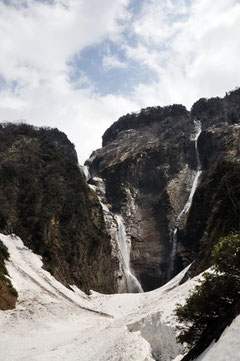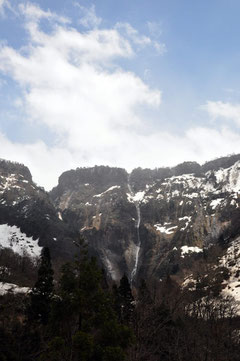The Highest Waterfalls in Japan
Shōmyō-daki and Hannoki-no-taki

At 350 m (1,148 ft) Shōmyō Falls (Shōmyō-daki) in Toyama Prefecture is the highest waterfall in Japan. Its twin, Hannoki-no-taki, only flows seasonally from April to July, when melting snow runs down from the Midagahara Plateau. When it flows, Hannoki-no-taki has a height of 497 m (1,640 ft), making it the highest waterfall in Asia, the second-highest being Kunchikal Falls in southwestern India (455 m/1,493 ft).
The falls can be accessed from Tateyama Station, which is an hour out of Toyama City on the Toyama Chiho Railway (¥1170). We went out on April 30th, the Friday of Golden Week, taking a bus between sheer mountain slopes that clearly illustrated why this was one of the major landslide sites in Japan. Drizzle at the station turned into icy flurries over the course of the twenty-minute ride, while around us the bordering mountains coalesced into cliffs capped with white-frosted trees. The high snow line dropped like the sides of a massive bowl as the moisture rose and the falls drew near.

This year, April 30th happened to be Shōmyō-daki’s official opening day, and we arrived to find a ribbon-cutting ceremony being recorded by two or three local TV crews in raincoats. We bypassed the ceremony to stroll twenty minutes to the base of the falls, arriving to stand on the bridge beneath the last of Shōmyō-daki’s four stages, water cascading down 126 m (413 ft) into the bowels of a snow pack the size of an aircraft carrier.
With as many reporters as visitors on hand, everyone was interviewed at least two or three times. As my girlfriend and I allowed ourselves to be directed through a series of awe-struck poses for a local paper, the mist lifted at last, and the cameramen and I all shared a sigh of relief as we finally got a decent shot against a mostly-blue sky.
Shōmyō-daki is an easy trip out of Toyama, and a good secondary option if, as we did, you find yourself with time to kill while waiting for the cable-car up to the Tateyama-Kurobé Alpine Route. Buses run about once an hour from right in front of Tateyama Station (¥500), but they only start on the official opening day, which is about two weeks after the opening of the heavily-trafficked Alpine Route.
Published July 2010. Photos © 2010 Michael Kanert.
